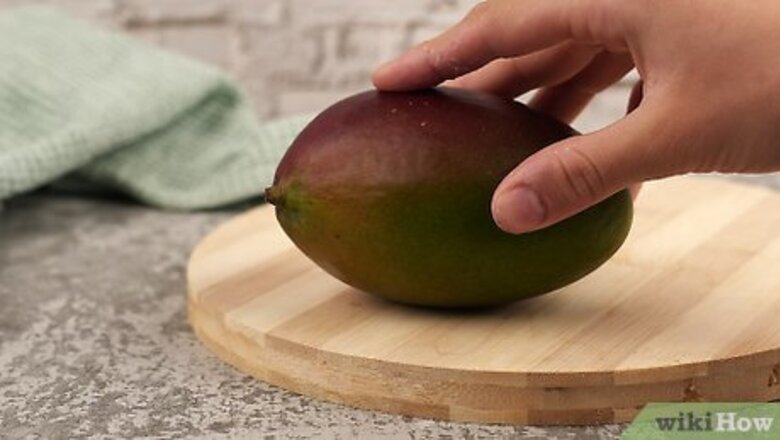
views
- Squeeze the mango gently. If it’s soft enough to dent, it’s ripe.
- Smell the mango at the stem. If it smells sweet and tropical, it’s good to go.
- Look for white or brown speckles on the fruit’s skin. If it has speckles, it's ready to eat.
Signs a Mango is Ripe
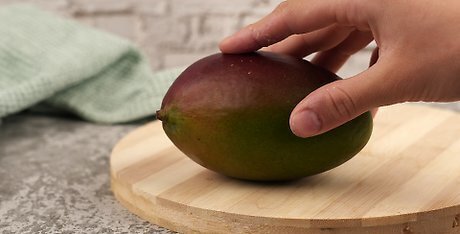
Squeeze the mango gently to see if it gives. Press on the mango with your fingertips. If the fruit molds slightly in your hand, it’s ripe. If the fruit is firm or squishy, it may be underripe or overripe. Think of it this way, if you can just barely make a mark in the fruit with the tip of your thumb, it’s ready to eat. If your thumb goes through the skin entirely and the fruit is squishy, it’s overripe and may be spoiled. If your thumb doesn’t dent the fruit, let it ripen more before eating. Alternatively, to avoid accidentally bruising the fruit, press the mango with your palm instead of your fingertips. Hold the mango in your hand and close your fingers around the fruit, pressing on it with the ball of your palm.
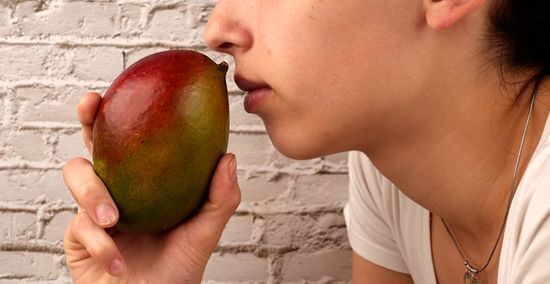
Sniff the stem end of the mango to check for a sweet aroma. If the fruit has a strong fruity, sweet smell, there’s a good chance it’s ripe. If the mango smells sour or alcoholic, it’s most likely spoiled and should be tossed out. A ripe mango’s smell should remind you of how a mango tastes: sweet, juicy, and tropical. A rotten or spoiled mango will smell bitter and alcoholic as the sugars inside ferment and cause a foul odor. Always sniff a mango at the stem, as this is where the aroma is the strongest.
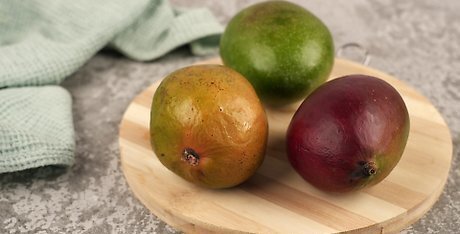
Match the mango variety to it’s ripe color. Contrary to popular relief, the color of a mango doesn’t always determine its ripeness. Each type of mango ripens to a different color; however, a red color indicates how much sun the fruit has gotten. Use this guide to determine if your type of mango is ripe based on color: The Ataulfo mango turns a deep, golden color when ripe. The Francis mango is a blend of green and gold when ripe. The Haden mango turns from green to yellow once ripe. The Keitt mango will remain green even once it becomes ripe. The Kent mango will remain mostly dark green but often has yellow undertones or dots. The Tommy Atkins mango provides little to no visual clues of ripeness. The Alphonse mango has purple to yellow skin once ripe. The Edward mango has skin that can be pink, yellow, or a blend of the two. The Kesar mango can remain green once ripe but will often take on a yellow hue. The Manila mango usually has a ripe orange-yellow hue but can turn pink. The Palmer mango can appear purple, red, yellow, or some mix of the three.
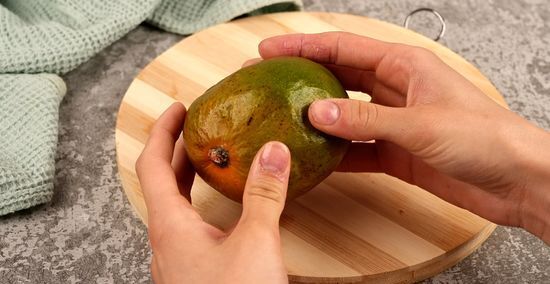
Check for white or brown spots on the mango. While this isn’t always a sure indication of ripeness, if the mango peel has some freckles, it may be a sign that it’s ready to eat. This occurs when the fruit inside has become sweet and the sugars have fully developed. A mango lacking speckles may still be ripe. Spots shouldn’t be relied on as your only indicator. Some mango varieties, like the Kent mango, can develop yellow spots instead of brown spots.

Pick up the fruit and feel if it’s heavy. A ripe mango will feel heavy for its size, especially compared to an unripe mango. Consider comparing the weight of a potentially ripe mango with a mango you know is unripe. The unripe mango should feel notably lighter than the other mango if it’s ripe.
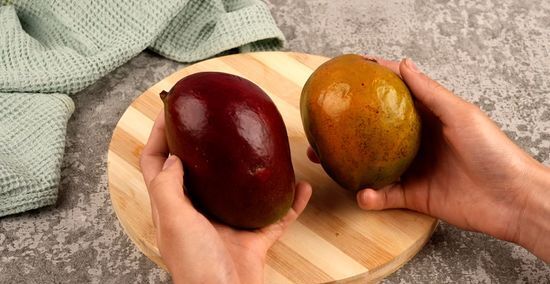
Notice if the mango is round or oblong. Depending on the type of mango you’re purchasing, the size and overall shape can help you decide whether or not it’s ripe. Most ripe mangoes have a hefty weight and are oval-like in shape. Here’s what to look for: The Ataulfo mango is small and has a flattened oval shape when ripe. The Francis mango is oblong and has a slight s-shape when ripe. The Haden mango is medium-sized and round to oval in shape. The Keitt mango is a large, oval-shaped variety. The Kent mango is large and oval-shaped. The Tommy Atkins mango is usually large and oblong. The Alphonse mango has an oblong shape. The Edward mango can have both round and oblong shapes. The Kesar mango usually has a round shape. The Manila mango has a notably skinny, slender appearance. The Palmer mango has an oblong shape when ripe.
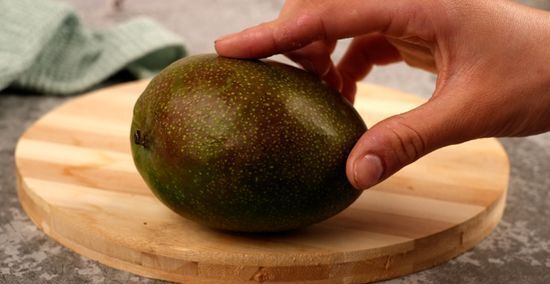
Feel the skin to see if it’s wrinkly. More often than not, a ripe mango will have a few wrinkles on its skin. Lightly rub your fingertips over the surface of the mango. It may be ready to eat if you feel ridges or textural differences. Keep in mind that the absence of wrinkles doesn’t necessarily mean the mango is unripe, so use this trick with other testing methods. If a mango is covered in deep wrinkles, it may be overripe. The Ataulfo mango is well-known for developing wrinkles as it ripens.
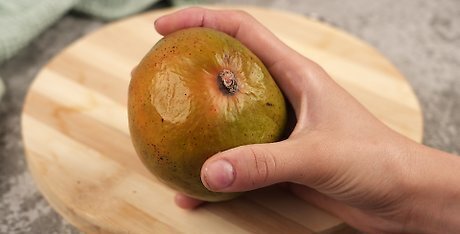
Notice if the skin around the mango’s stem is plump. If it’s round and swollen, the mango is ready to eat. If it’s flat or sunken in, the mango is unripe. All mangoes have a flat stem before they’ve ripened. As the fruit matures, the pulp, juices, and sugars inside grow and develop, pushing out the stem.
Ripening an Unripe Mango

Place an unripe mango in a brown paper bag for 2 days. Believe it or not, putting a mango inside a paper bag can help speed up the ripening process. Fruit naturally produces ethylene gas as it ripens, and trapping the gas inside the bag with the fruit can make it ripen faster. Check on the fruit every day to see if it’s ripe enough to eat. Try placing a ripe banana inside the bag with the mango to produce even more ethylene gas.
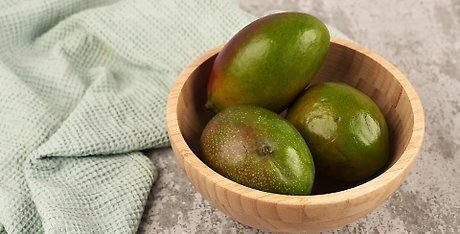
Leave the mango out at room temperature. It takes fruit longer to ripen in the refrigerator, so let it sit on your counter or in a fruit bowl for at least 2 to 7 days. Cold temperatures slow the ripening process dramatically, so a gentle transition to warmth can help the fruit ripen naturally.

Put the mango into the fridge once it ripens. Ripe mangoes must be eaten immediately, as their deliciously sweet flesh can quickly become overripe. If you don’t plan on eating a ripe mango that day, store it in the refrigerator for up to 5 days, as the cold temperature slows down the ripening process. Consider cutting a ripe mango to store in the freezer to use in smoothies later. Preserve ripe mangoes by canning or dehydrating them to snack on or cook later.













Comments
0 comment